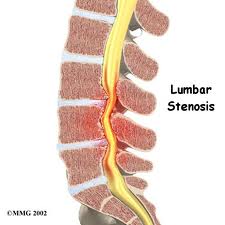What is Spinal Stenosis?
We’ve been reviewing some of the common spinal conditions on the New Jersey Spine Specialists blog recently, and spinal stenosis – one of the most common spinal conditions – certainly warrants discussion. Stenosis refers to a narrowing, or constriction. In spinal stenosis, the spinal canal narrows, and puts pressure on the nerves branching out from the spine, and sometimes on the spinal cord itself, causing pain, tingling, numbness, and weakness in the extremities. Spinal stenosis occurs predominantly in two locations of the spine and is defined by the location. Lumbar spinal stenosis occurs in the lumbar or lower region of the back, and cervical spinal stenosis affects the cervical or neck region.
The structures that contribute to and can cause spinal stenosis include the discs between the vertebrae, the facet joints, and the ligaments, which help to connect the vertebrae to each other. The narrowing of the spinal canal may result from abnormal bone growth and/or tissue growth. Most cases of spinal stenosis are acquired and develop slowly over many years due to the normal aging process and due to generalized wear and tear of the spine. Some causes of acquired spinal stenosis include: osteoarthritis, bone spurs, herniated discs, spondylolisthesis, trauma to the spine, and normal aging. There is also a less common hereditary form of spinal stenosis in which the diameter of the spinal canal is unnaturally small from birth. A healthy lifestyle including exercise, good nutrition, and maintaining proper weight can help prevent spinal stenosis.
How to Treat Spinal Stenosis
For those who are affected and are symptomatic, spinal stenosis treatment options include: physical therapy, spinal stenosis exercises, medications, and lumbar steroid injections. In cases that fail to improve with these treatment measures, surgery for spinal stenosis may be recommended. More traditional procedures like lumbar laminectomies with or without fusion have been well studied and have provided excellent longer-term pain relief for properly chosen patients. Although minimally invasive spinal surgery such as laser spinal surgery and endoscopic surgery are often advertised, these newer techniques unfortunately are less effective and often fail to provide adequate relief of pain and symptoms and can also be dangerous. However, for certain patients who are properly chosen, less invasive surgical techniques may be an option. With the nonoperative and surgical treatment options mentioned, many individuals previously destined for a life of pain now have viable choices with regards to their treatment. At New Jersey Spine Specialists, we recommend anyone affected by spinal stenosis seek the best treatment possible available with qualified specialists. If you have more questions, we invite you to schedule a consultation at one of our offices, which are conveniently located in Summit or Montclair New Jersey, and where our orthopedic surgeons are board certified and have completed specialized fellowship training.







